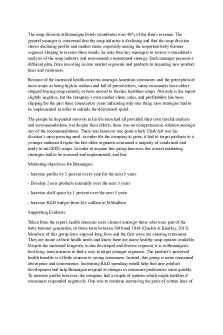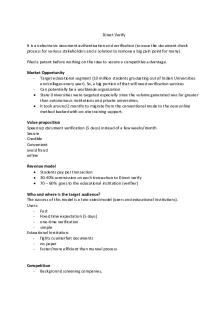Direct Verify - Analysis of Case study PDF

| Title | Direct Verify - Analysis of Case study |
|---|---|
| Course | E-Business |
| Institution | Concordia University |
| Pages | 6 |
| File Size | 166.3 KB |
| File Type | |
| Total Downloads | 72 |
| Total Views | 199 |
Summary
Analysis of Case study...
Description
Direct Verify It is an electronic document authentication and verification (to ease the document check process for various stakeholders and a solution to remove a big pain point for many) Filed a patent before working on the idea to secure a competitive advantage. Market Opportunity - Target educational segment (10 million students graduating out of Indian Universities and colleges every year). So, a big portion of that will need verification services - Can potentially be a worldwide organization • State Universities were targeted especially since the volume generated was far greater than autonomous institutions and private universities. • It took around 2 months to migrate from the conventional mode to the new online method backed with on-site training support. Value proposition Speed up document verification (5 days) instead of a few weeks/month Secure Credible Convenient avoid fraud online Revenue model • Students pay per transaction • 30-40% commission on each transaction to Direct verify • 70 – 60% goes to the educational institution (verifier) Who and where is the target audience? The success of this model is a two-sided model (users and educational institutions). Users: - Fast - Fixed time expectation (5 days) - one-time verification - simple Educational Institution: - fights counterfeit documents - no paper - faster/more efficient than manual process
Competition - Background screening companies,
- Fax, email or snail mail through which verification could happen. Competition is not a threat because time is saved, not as secured compared to direct verify, not consistent in terms of speed (5 days max). Standard process which can be seen as more convenient and simpler. Reduce cost of verifiers, better ability to check the status. The company is a pioneer Different types of approaches/ Market Strategy
B2C
B2B
Direct verify
Users (students)
Verifiers (edu. Inst)
B2B with educational institutions: more formal approach and in-person meetings (direct marketing. B2C with users: Mass advertisement Strength Strong management team Website systems development: everything was happening at the same time in order to present something to clients as fast as possible Weaknesses - No money - no existing user base or technological expertise - no brand credibility had to build trust E-commerce presence map Website/app: High presence Social media: Marketing purposes at first to gain traction. Later on they started to understand that they should use it for loyalty and explain how to recognize fraudulent documents. Mostly used to inform customers and explain why their service was more useful/secure/fast compared to other verification methods.
offline media: Marketing purposes only Facebook was not effective, so they used Google AdWords instead (search engine optimization) Software Started off with Tahoe-open source and Java, but they decided to switch to a .Net framework, and the money they invested in Java was a sunk cost. System Design • For building the website, they used their own in-house design (IIT) and decided to host the site in-house as well (completely in house) • Positive points: More economical, control of their own data/security due to a small chance of losing confidential data. • Negative points: maintenance of the server requires manpower and cost increases for salary, responsible for backups (for the server, maintenance). • Later on, they switched to cloud based computer services with Microsoft Azur. They are now able to focus on marketing and working on improving services offered • System design can be considered a mixed responsibility (Building the site but the hosting of the site is outsourced)
Management Team Mr. Avira became Chief Executive Officer (CEO) • 3 software developers were hired (code with Java) and given the job to develop the user interface • 2 interns were hired to assist in back-end coding • One was a credit card operations manager CFO • • •
The other brother the other an auditor at KPMG Background as an audit (helpful in this type of business because it adds credibility, know what the problem is, get into the mind of potential customers and understand the difficulties).
Chief Technology Officer (CTO) was hired to accelerate the product development • Decided that the technology platform would use PhP and .NET. Tahoe was chosen initially since it was an open source software (free, open, secure). Switched to .NET framework (security features provided by Microsoft). • Tahoe, wasn’t popular enough, there weren’t enough specialists. Because .NET was more popular, there were more developers than knew this technology • CTO was in charge of Human Resource Chief Marketing Officer (CMO)
• How money was used People with telecom and insurance background with Masters in Business Administration (MBA) were hired for the sales roles (known to take and achieve impossible sales targets). Client service team was created to ensure satisfaction of existing clients and manage recurring issues. COO •
From Vodafone
Þ Complete Management team Then hired more people
PROBLEM: • Manual system used in processing verification PATENT • To avoid duplication • For good firm valuation IIT INCUBATOR - For credibility - Support - Tech expertise Had a lot of difficulty finding their first client CASH - 70% to find new customers - 30% to find new investors COSTS -
Sales 45% HR 35% Rent & Miscellaneous 18% Tech 2%
PROFIT MARGIN = 30-40% MAIN goal: maintain fiscal discipline (smooth financial operations/ keeping costs at minimum) Philosophy: go straight to the USERS of the verifications
Marketing strategy: - Face to face - Google - Then added social media - Microsoft Added in a client service team
QUESTIONS 1. What technology decisions did the leaders of DirectVerify have to make to get the company started? • No technological expertise, so they surrounded themselves with people that would be able to complement their skills at the Indian Institute of Technology (IIT Madras). They wanted to incubate their idea (helps startup develop by providing services such as management training and office space). • 45% was spent on sales, marketing & traveling, HR- 35%, rentals & miscellaneous expenses- 18%, technology- 2%. i. Used the payment method offered by EBS since it had lower charges 2. How did the management secure investment to finance the project? • Vendor at Citibank believed in the idea and invested $100,000 • Convincing clients that they take money from customers not them (Surcharge from the user) and that they don’t lose anything by signing up. • Spent 70% of their time with customers and 30% trying to find potential investors. High Net worth individual (HNI) invested a significant amount in the firm in exchange for equity. 3. What were the challenges in getting the business going? • Do not want their idea to get stolen (so they filed a Patent Cooperation Treatyapplicable globally valid for 5 years) in order to secure a good valuation for the firm when they want to raise money. • No prototype to show potential investors, no technological expertise • Finding the first client i. companies don’t want to be the one’s taking the first risk ii. No proof of concept iii. Had no client list iv. Took them 5 years (2007-2012) to get their 1st customer • Finding investors. 4. What was the timeline in getting the website up and running? Product was available in June 2011, but they did not have a single customer.
5. How do you assess the profit potential of DirectVerify? • Available in India, Turkey, Israel, the Emirates, recently started to target the US Targeting universities, railways, embassies, medical associations • High success rate in growth and profitability. High barriers to entry (it takes a lot of time to understand how the whole system works). • Targeted embassies, banks, railways, medical associations, police verification, passport offices o Local connect and the local language MATTERED Every institution was provided with a pilot run and received personalized onsite support. Offered advance payment to the verifiers and later squared it off with the money collected from the users and this was the prime reason they were able to secure clients who did not trust them. Believes that it differentiates itself through Process, Technology and Networks
SWOT ANALYSIS FOR DIRECT VERIFY
Strengths - Experience - Motivated
Opportunity - Huge market size - Potential to capture a significant share of the market (first movers)
Weakness - No IT background - No existing user base - No funds
Threats - Security breaches - Duplication of business model (someone who has more money, that can bring the product to the market faster) but they got a patent to protect themselves...
Similar Free PDFs

Sephora Case Direct Study
- 2 Pages

Analysis of Nike - Case Study
- 27 Pages

Analysis of Zara - case study
- 1 Pages

Sports Direct Case Study M&O
- 44 Pages

Business Case Study Analysis
- 9 Pages

Biopure case study analysis
- 6 Pages

Jetblue Case Study Analysis
- 8 Pages

Microsoft Case Study Analysis
- 12 Pages

Brannigan - Case Study Analysis
- 7 Pages

VolksWagen case study analysis
- 6 Pages

IKEA Case Study Analysis
- 7 Pages

Case Study Analysis
- 13 Pages

Sample Case Study Analysis
- 8 Pages
Popular Institutions
- Tinajero National High School - Annex
- Politeknik Caltex Riau
- Yokohama City University
- SGT University
- University of Al-Qadisiyah
- Divine Word College of Vigan
- Techniek College Rotterdam
- Universidade de Santiago
- Universiti Teknologi MARA Cawangan Johor Kampus Pasir Gudang
- Poltekkes Kemenkes Yogyakarta
- Baguio City National High School
- Colegio san marcos
- preparatoria uno
- Centro de Bachillerato Tecnológico Industrial y de Servicios No. 107
- Dalian Maritime University
- Quang Trung Secondary School
- Colegio Tecnológico en Informática
- Corporación Regional de Educación Superior
- Grupo CEDVA
- Dar Al Uloom University
- Centro de Estudios Preuniversitarios de la Universidad Nacional de Ingeniería
- 上智大学
- Aakash International School, Nuna Majara
- San Felipe Neri Catholic School
- Kang Chiao International School - New Taipei City
- Misamis Occidental National High School
- Institución Educativa Escuela Normal Juan Ladrilleros
- Kolehiyo ng Pantukan
- Batanes State College
- Instituto Continental
- Sekolah Menengah Kejuruan Kesehatan Kaltara (Tarakan)
- Colegio de La Inmaculada Concepcion - Cebu


